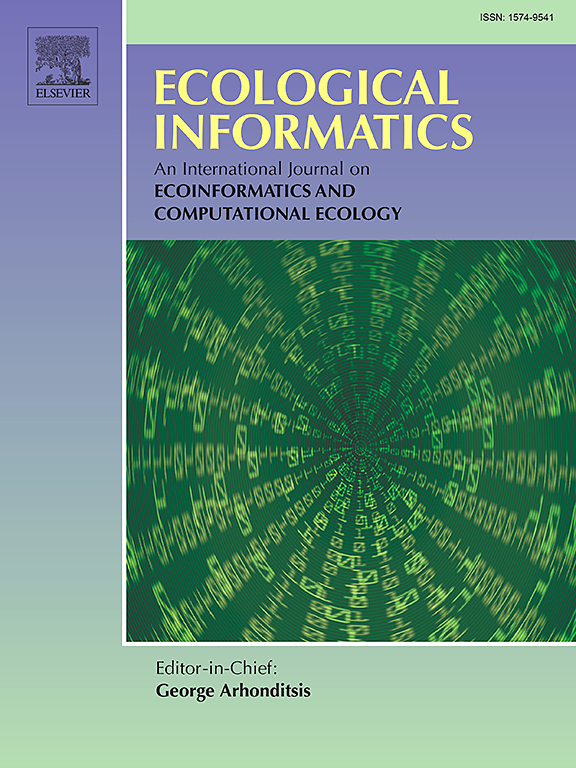Marine soundscape forecasting: A deep learning-based approach
IF 5.8
2区 环境科学与生态学
Q1 ECOLOGY
引用次数: 0
Abstract
Advancements in autonomous monitoring technology over the past decade have led to the widespread use of marine soundscape monitoring to assess marine environments. These environments are rapidly changing and exhibit complex temporal patterns and trends across different frequencies, influenced by biotic and abiotic factors as well as extreme events. This variability introduces a high degree of unpredictability. Despite the rapid development of anomaly detection algorithms and deep-learning models for forecasting, their application to marine soundscapes remains unexplored. This study investigates the use of the unsupervised learning-based isolation forest (iForest) technique to detect anomalous events in marine soundscapes that cause sudden changes in sound levels. Additionally, it evaluates the potential of deep-learning models for estimating trends and forecasting soundscapes while identifying the factors that influence their accuracy. To address these questions, I used marine passive acoustic monitoring data collected from the Taiwan Strait in 2017. The iForest method identified a higher number of anomalies (∼17) in the lower frequency range (10–500 Hz) with a precision of 75 %, primarily due to typhoons, cold bursts, and flooding. In contrast, precision was around 50 % in the mid (500–3000 Hz) and high (3000–24,000 Hz) frequency ranges, where most anomalies resulted from sudden changes in the acoustic behaviors of fish and shrimp, respectively. To analyze trends in marine soundscapes at different temporal scales—annual, seasonal, and diurnal—the anomaly-informed NeuralProphet model was employed. Results showed that NeuralProphet effectively captured annual and seasonal trend changes compared to the traditional singular spectrum analysis method. Beyond NeuralProphet, I also tested two recently developed state-of-the-art forecasting models—time-series dense encoder (TiDE) and neural hierarchical interpolation for time series (NHiTS)—to predict marine soundscapes. In the seven-day ahead seasonal forecasting task, the NHiTS model outperformed both TiDE and NeuralProphet. The deep-learning forecasting models produced more accurate predictions in the mid (500–3000 Hz) (MAE ∼0.4–1) and high (3000–24,000 Hz) (MAE ∼1.5–3) frequency ranges, where seasonal acoustic activity from fish and shrimp strongly influenced sound levels. In contrast, forecast accuracy declined in the lower frequency range (10–500 Hz) (MAE ∼4–8), where sound levels are more stochastic due to anthropogenic and meteorological influences. The findings of this study highlight the potential of deep-learning models for forecasting and trend estimation in marine soundscapes. These models not only improve our understanding of the conditions under which trends change but also enhance our ability to anticipate anomalies and forecast failures. This capability could provide researchers and policymakers with a powerful tool for monitoring transitions and deviations across different temporal scales, ultimately contributing to the conservation and management of marine ecosystems.

海洋声景预测:基于深度学习的方法
在过去的十年中,自主监测技术的进步使得海洋声景监测被广泛用于评估海洋环境。这些环境正在迅速变化,并在不同频率上表现出复杂的时间模式和趋势,受到生物和非生物因素以及极端事件的影响。这种可变性带来了高度的不可预测性。尽管异常检测算法和用于预测的深度学习模型发展迅速,但它们在海洋声景中的应用仍未得到探索。本研究探讨了使用基于无监督学习的隔离森林(ifforest)技术来检测海洋声景中引起声级突然变化的异常事件。此外,它还评估了深度学习模型在估计趋势和预测音景方面的潜力,同时确定了影响其准确性的因素。为了解决这些问题,我使用了2017年在台湾海峡收集的海洋被动声监测数据。ifforest方法在较低频率范围(10-500 Hz)内识别出更多的异常(~ 17),精度为75%,主要是由台风、寒流和洪水引起的。相比之下,在中(500-3000 Hz)和高(3000 - 24000 Hz)频率范围内,精度约为50%,其中大多数异常分别是由鱼和虾的声学行为的突然变化引起的。为了分析不同时间尺度(年、季节和日)的海洋声景趋势,采用了异常通知的NeuralProphet模型。结果表明,与传统的奇异谱分析方法相比,NeuralProphet可以有效地捕捉年度和季节趋势变化。除了NeuralProphet,我还测试了最近开发的两种最先进的预测模型——时间序列密集编码器(TiDE)和时间序列神经分层插值(NHiTS)——来预测海洋声景。在7天前的季节预报任务中,NHiTS模型的表现优于TiDE和NeuralProphet。深度学习预测模型在中(500-3000 Hz) (MAE ~ 0.4-1)和高(3000 - 24000 Hz) (MAE ~ 1.5-3)频率范围内产生了更准确的预测,其中来自鱼和虾的季节性声学活动强烈影响声级。相比之下,在较低频率范围(10-500 Hz) (MAE ~ 4-8),由于人为和气象影响,声级更具随机性,预报精度下降。这项研究的发现突出了深度学习模型在海洋声景预测和趋势估计方面的潜力。这些模型不仅提高了我们对趋势变化条件的理解,而且提高了我们预测异常和预测故障的能力。这种能力可以为研究人员和政策制定者提供一个强大的工具,用于监测不同时间尺度的过渡和偏差,最终有助于海洋生态系统的保护和管理。
本文章由计算机程序翻译,如有差异,请以英文原文为准。
求助全文
约1分钟内获得全文
求助全文
来源期刊

Ecological Informatics
环境科学-生态学
CiteScore
8.30
自引率
11.80%
发文量
346
审稿时长
46 days
期刊介绍:
The journal Ecological Informatics is devoted to the publication of high quality, peer-reviewed articles on all aspects of computational ecology, data science and biogeography. The scope of the journal takes into account the data-intensive nature of ecology, the growing capacity of information technology to access, harness and leverage complex data as well as the critical need for informing sustainable management in view of global environmental and climate change.
The nature of the journal is interdisciplinary at the crossover between ecology and informatics. It focuses on novel concepts and techniques for image- and genome-based monitoring and interpretation, sensor- and multimedia-based data acquisition, internet-based data archiving and sharing, data assimilation, modelling and prediction of ecological data.
 求助内容:
求助内容: 应助结果提醒方式:
应助结果提醒方式:


